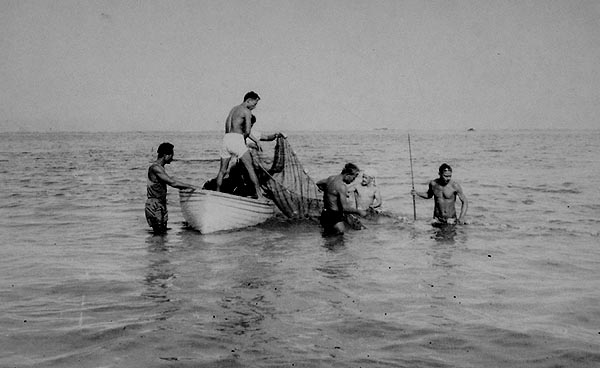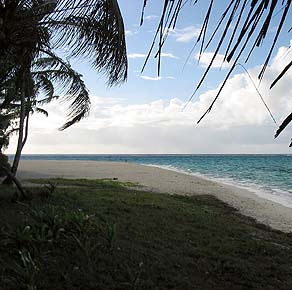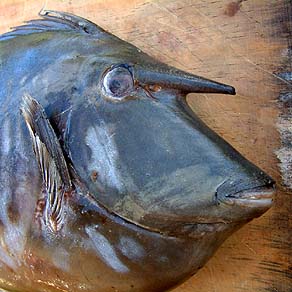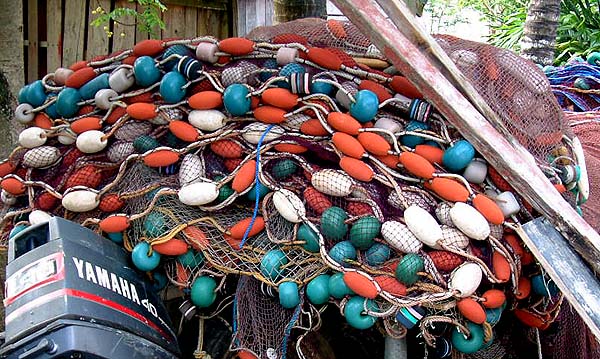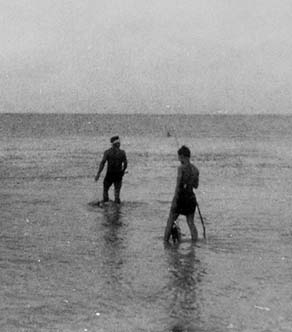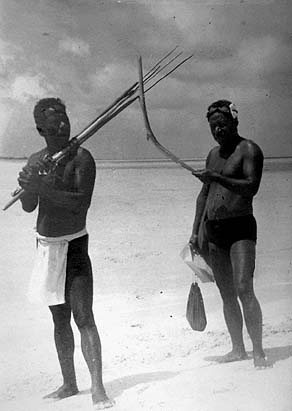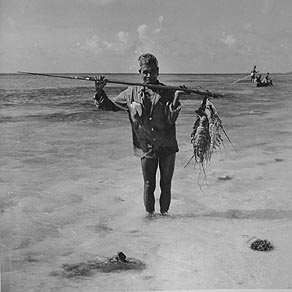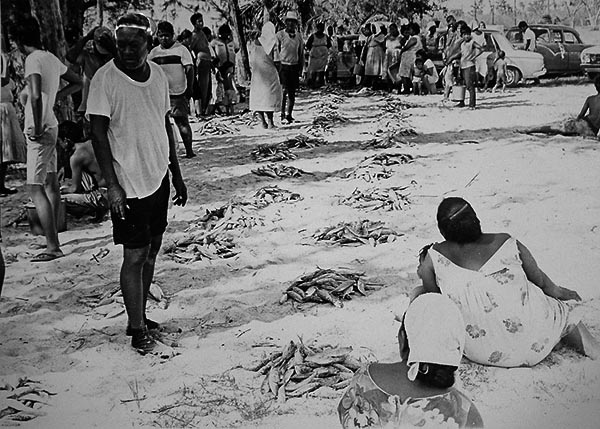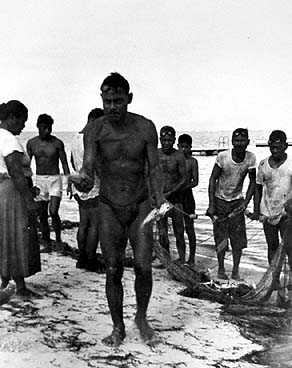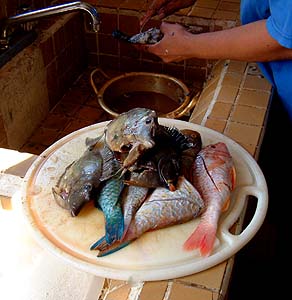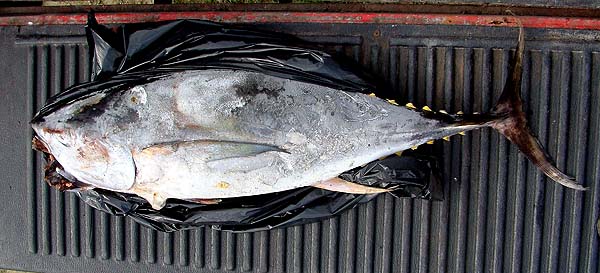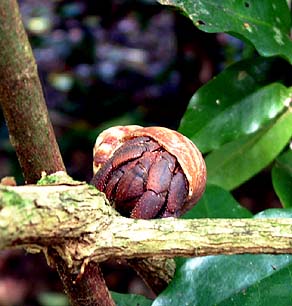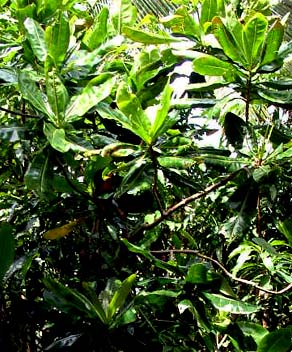 |
 |
 |
|||||
|
|
|
|
|
|
|
|
|
|
|
|||||||
|
|
|
|
|
|
“I love to go fishing,” smiles Estella. “When my husband was still alive and was healthy, we used to go to the reef outside. Only myself and my husband, we’d take our net fishing and we’d go out from Acho’ Dánkolo, the big rock over there. We planted our net and then we went outside to the reef and we start chasing the fish inside. Then we would come inside and take our net."
|
||
|
|
||
“Sometimes we’d catch fifty pounds of fish. And that’s hangon, Black Surgeon fish. Hangon, and tataga (unicorn fish), hiteng (rabbit fish), and palakse’ (parrotfish). Those are the fish that we were catching. "Then, if we took our boat and we got to Managaha, on the sand we’d put our net over there and then we’d pull it out to where it’s a little bit deeper. About 5:00 o'clock in the afternoon we'd set our net out there. We'd set our net and then we would go inside and sit for a while on the island. Or we would eat our dinner, because many times I brought our dinner and we’d eat on Managaha. "And after we finish eating, we would go out and look at the net. Just by touching the net you know that there’s plenty of fish because the net keeps on moving. When we went to pull in the net, it was full of tarakitu (yellow-spotted trevally)."
|
|
|
“The most prized fish today and yesteryears is the unicorn fish," Ben says. "Usually they grow maybe 14, 15 inches long and they’re about six inches wide. They have two blades on each side of the cadle, the tail side in the back, and then there's this unicorn horn in the front. "Those are usually prized fish, along with the rabbit fish, the one that we spear at night. If you catch one of those, everybody at home is smiling and happy. We cook the unicorn fish primarily over fire, barbecue it. I have seldom seen people cook it other ways. Some people chop it up and cook it with coconut milk. Others prefer the flavor of barbecue. We always barbecue rabbit fish."
|
|
|
|
Dan's fishing net.
|
“Net fishing is an art,” Ben continues, “and it is done primarily during the summer. The water is much better. The current is practically nonexistent, and the net will stand up nicely rather than falling over. There are traditional fishing grounds where they they used to set the net in a certain way. My brother does that today—no longer today since they banned net fishing—but they set it in the way from the old times: you would have a net with a pocket and people lined up all over the other side and we would swim in and chase the fish in. Once the net is set up, we would slap the water as we swim down toward it."
|
||
|
|
||
“In the olden days, when they dropped you in the water to chase fish into the net, you better not stop, you better keep going because there’s guys and older men who would be pulling the boat and they would be slapping the water with a pole, and if you’re slow, you’re going to get hit on your head or on your back, so you learned to swim fast. And we had no fins at that time, so you had to swim fast. We learned this art and we perfected it as we grew up. “Today everybody has fins and so it helps them to swim faster and we can have more settings of nets. In the olden days, probably two, three at most. Today we can do five or six settings of the net. Keep on going, move to another place, set it up again and then go on to another place and keep fishing that way."
|
|
|
"After we chase the fish into the net, we close it, and we go inside the net. If a tremendous number of fish comes into the net, they will go right to the end, where there is a pocket. We wait until the manager or the owner of the net tells us to move in, and then we swim in slowly and start pushing the fish into the pocket. Then the manager will tie that up. After that, we will be fishing inside the net where the fish can’t run away too far among the coral. “It’s a very aggressive activity inside there. If you’re not used to this kind of fishing, you’re going to get speared! You have to be very active, dodging spears. Normally we don’t allow spear guns. A spear gun is very lethal in the fishing net with 20-30 people inside, so we only use hand spears, and in those days there isn’t any elastic band to propel the spear. But you still get speared. Sometimes older folks would spear something and one of us younger, more energetic guys would come over and take up our spear and spear their fish, and they would pull our mask down,” Ben laughs.
|
"You don’t take home what you spear; normally you put it on the boat that holds all the fish, so you don’t take fish on your own. It’s a communal thing, everybody fishes for one pot, so to speak. Nobody takes home their own fish. Nowadays it’s changing. You go out and you catch fish inside the net, you put it in your line, and you get to take that home. "You know, now we’ve seen the dollar sign, and lots of people like to go and sell their own fish. But we still celebrate a lot of things here. We celebrate birthdays, we celebrate baptismal, we celebrate marriage, we celebrate the end of rosary. We have all kinds of excuses to make parties. I like it that way. It brings people more closely together when you share the bounty you’ve harvested. I think that’s why we’re still unique in this village. We still tend to do things together."
|
|
|
"But the beauty of fishing is not so much about how many fish we catch. The beauty of it is how much we’re going to eat on the boat raw. We eat raw fish on the boat. We sashimi, and what we call kelaguen. It’s a mixture of shoyu, lemon or lime, and maybe hot pepper and we would just dip it in there and we eat it raw. "There are times when we bring coconut husks, the coconut that is already husked, and we use that to burn so that we can cook our fish on the boat. We would take the dried husk from older coconuts, the one that has the meat already a good size. And we'd build a fire inside the husk and we’d put our fish in there and hold that out away from you, so that wind can come in and provide oxygen for the fire to continue to burn."
|
|
|
|
|
“Now in the olden days,” Ben says, “ when the participants of net fishing would get back, we would line up and they would split the fish. They would take 50% of the fish for the net owner, and 50% for the people who fish with the net. And in that 50% for the owner, they would separate some more for the villagers. First they would give to elders, to those who are sick, and if there was some left over, some other families would receive according to clanship. "The rest of us would be in a line, and they would throw the fish in front of us and we would gather them together. They divided it amongst almost everybody in the village, everyone gets fish from this effort of going out and doing net fishing. And when that’s done, you string them up and take them home. My grandmother would be very, very happy because normally we would get a lot of fish."
|
||
|
|
||
“During the Japanese time the custom of our men who went out fishing is that when they returned from fishing and kids were out there swimming in the ocean, the men didn't wait for the children to ask for fish” recalls Rosa Castro. “Their kind heart showed by giving these children fish from their fishing line. The fishe were for the kids to give to their parents.” "My godfather made me goggles," Ben says, "and that’s what I used to go spear fishing. He made them by hand. They are very talented, the older folks, I guess because they had to be. They’ve got to make something; otherwise, they can’t go fishing, so they made me goggles, and I was so impressed with my goggles. I cherished these goggles. I went fishing every weekend with the old folks."
|
|
|
"Normally, before going fishing we’re not supposed to walk in the cemeteries. Another thing that I was told, this Carolinian uncle of mine, told me that if you dream and see blood in your dream, go fishing; you will catch plenty of fish. I haven’t seen a lot of blood in my dreams, but I still go out and fish. "And when we come back from fishing, we take one or two fish and hang them up out there on the beach. We call it ahome in Carolinian. It doesn’t have a name in Chamorro. Every once in a while, you see a fish hanging out there in the trees. Don’t touch it. It’s an offering to the spirit of the ocean (animu tasi). We pay our respect for the bounty of the ocean by also giving food for the Spirit. That is still practiced today."
|
|
|
|
|
"I became interested in offshore fishing such as trolling for tuna and learned from John’s father, Jose Tenorio, who would go out fishing by himself, trolling, and would catch a lot of tuna. And so I asked him, ‘Can I go with you?’ and he took me out and he showed me a lot of ways to prepare for the lures, the kinds of hooks that we needed to bring with us, and he started teaching me how to follow the birds. Mostly notty terns and ferry terns; and for bigger fish you look for booby terns. "I didn’t know in those days why he followed the birds. But now I know the birds associates with tuna, so wherever the birds are, there’s got to be tuna there. These big fish would chase smaller fish, their food, and would chase them very close to the surface of the water, and the birds would see this school and they would dive down to eat them, and that tells us that the tuna is very close to the surface. So you would bring your boat to where the water boils, and very likely you would be hooking up tuna. This is outside the reef, maybe five, ten miles outside the reef."
|
||
|
|
||
“There was hardly any rod and reel at that time,” Noel recalls of line fishing in the lagoon, “so we used a small piece of bamboo and you just throw out the line, with a small bottle for a float on the fishing line before the hook, and we’d just throw it down from the boat. “For bait we used hermit crab. What we’d do is in the nighttime we’d go look for hermit crabs. Then we’d collect them, remove the shell, get the guts and then take the entire body and crush it. It’s an old technique that has still survived. We crush the crab body, then we just sprinkle it. We look first at the swell, where it’s coming from, then we’ll paddle there. We will sprinkle a lot and then move the boat to that area so the wave will carry all of the crab stuff towards us.”
|
|
|
“We use poison also, a local potion,” Dan says. “Not clorox; it’s an herbal potion. It’s only a root. We call it derris. That will knock out the fish in fifteen minutes. If it’s a smaller fish then it will die. A bigger fish like the tataga, you can catch with this herbal root, derris. You crush that and put it in and the fish will come out from the rock drunk already. They really are drunk. Then they're very easy to catch.” “Like herbal medicines, derris not really harmful,” Dave adds. “Not really harmful for the fish. Chlorine is very harmful. The old people were doing this when they had to go in a group.We learned this from our elder people. But sometimes still when we come back here, we take that herbal potion and we go out fishing.”
|
|
|
|
"In those days there were a lot of fish," Pete recounts. "We didn’t need to use a net. You could go out free diving and catch a lot of big fish. You could choose what kind of fish you wanted to catch. We did spear fishing mostly during daytime. Sometimes we’d go at nighttime when we needed to catch what we call hiteng, rabbit fish. Sometimes we go outside the reef just to catch lobster and things like that. But now we just swim from the beach all the way back to the reef. There are very few fish you can catch there. But before, we didn’t need to go far away from the beach."
|
||
|
|
||
Fishing is a central feature of life in Tanapag, and more cultural features relating to fishing will be discussed later. Now we invite you to look at local terminology regarding fish and fishing as presented in this chapter's Language page. Our next chapter focuses on the Land.
|
||
|
|
||
|
|
|
|
|
|

|
| Tanapag Home | Map Library | Site Map | Pacific Worlds Home |
|
|
|
|

|
|
|
|||
| Copyright 2003 Pacific Worlds & Associates • Usage Policy • Webmaster |
|||
